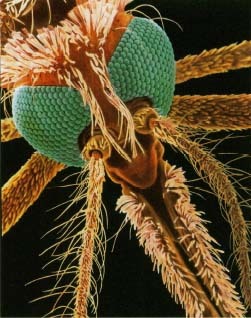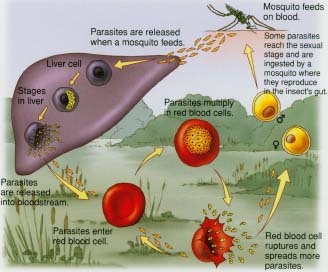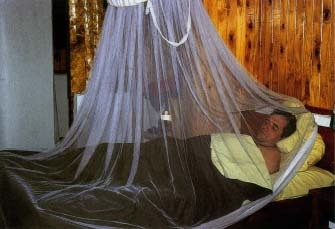Malaria
Malaria is a disease caused by a parasite called Plasmodium that is spread to humans by the bite of an infected Anopheles mosquito.
KEYWORDS
for searching the Internet and other reference sources
Anopheles mosquitoes
Chloroquine
Infection
Parasites
Plasmodia
Quinine
Staging a Comeback
Malaria is a serious disease that once seemed to be headed for the history books. From the 1940s through about 1970, it was disappearing. Insecticides, or insect-killing chemicals, had been developed for killing the mosquitoes that carry malaria before they could spread the disease. In addition, an inexpensive medicine called chloroquine had been developed for killing the malaria parasite after humans had been infected.
Then things took a turn for the worse. Most species of the mosquitoes that carry malaria developed resistance to at least one insecticide. This means that they could no longer be killed by it. In addition, many strains of the malaria parasite developed resistance to chloroquine and other drugs. At the same time, there was a rise in global travel and trade that spread these drug-resistant parasites around the world. The result is that malaria has made a comeback. In many countries, especially in Africa, it takes a huge toll in health, money, and lives.
What Is Malaria?
Malaria is a disease that is caused by a parasite, a living thing that lives and feeds on another living thing without helping its host in any way. The parasites that cause malaria are tiny, single-celled creatures known as protozoa. The four types of protozoa that cause malaria all belong to a category known as Plasmodium. Of these, Plasmodium falciparum is the most common and the deadliest.
Malaria parasites are spread to humans by the bite of an infected Anopheles mosquito. Such mosquitoes are found in almost all countries in the tropics (region around the equator) and subtropics (region just beyond the tropics).
In fact, malaria is a public health problem in more than 90 countries, where two out of every five people in the world live. There are 300 to 500 million cases of malaria each year, and more than 1 million of these cases lead to death. Although malaria is found around the world, more than 9 out of 10 cases occur in Africa south of the Sahara Desert. Most of the deaths there occur among young children, especially in rural areas where the people cannot reach good medical care. This is especially unfortunate because malaria can be cured if it is diagnosed early and treated promptly.

How Does the Malaria Parasite Cause Disease?
The Plasmodium parasite that causes malaria is carried by the Anopheles mosquito. When an infected mosquito bites a person, it can pass tiny, immature forms of the parasite into the person's body. The immature parasites travel through the person's blood-stream to the liver, where they develop and multiply.
The parasites then reenter the bloodstream and invade the red blood cells, which carry oxygen from the lungs throughout the body. Some of the parasites reach a sexual stage. If these are sucked up by another mosquito drinking its next blood meal, they can meet in the mosquito's gut. There, they can start a whole new generation of malaria parasites.
While in the red blood cells, the parasites continue to multiply. After 48 to 72 hours, the red blood cells break open and release more parasites into the bloodstream. The person then has symptoms such as chills, fever, and headache. The fever lasts for several hours. Then the person starts sweating and his body temperature falls. This cycle of symptoms comes and goes every 48 to 72 hours, following the life cycle of the parasites. Each cycle worsens the person's anemia, or lack of red blood cells. As a result, less and less oxygen reaches the brain and other organs.
Who Is at Risk?
Malaria is mainly a problem in poor countries. Rural areas in such countries are hit particularly hard. Mosquitoes are most likely to spread malaria during the rainy season, when families in these areas are busy farming. Illness then makes it tougher for them to survive. There are about 1,000 cases of malaria a year in the United States, mostly among travelers returning from such areas.
Malaria is a special threat to young children in places where it is common. Worldwide, about 3,000 children under age five die of the disease each day. Malaria is also particularly dangerous for women who are pregnant. It may increase the risk of the baby being born early or dying before or at birth.
What Are the Symptoms?
The symptoms of malaria include chills, fever, sweating, headache, muscle aches, and tiredness. Other possible symptoms include vomiting, diarrhea, and coughing. In its early stage, the disease may be mild, resembling the flu. If it is not treated, however, malaria caused by the Plasmodium falci-parum parasite may get much worse, leading to liver and kidney failure, seizures, coma, and sometimes death.
Although the symptoms caused by other Plasmodium parasites are less severe, the parasites can remain in an inactive state in the liver for long periods. Later, the parasites can become active again, and the symptoms can reappear after months or even years.
The first symptoms of malaria usually start within one to three weeks after a person is bitten by an infected mosquito. However, the time can stretch to several months in some cases. Travelers who come down with a fever or flu-like illness during or after a trip to an area where malaria is a problem should see a doctor right away.
How Is Malaria Treated and Prevented?
To test for malaria, a doctor checks a blood sample for malaria parasites. If they are found, prompt treatment is critical. There are several drugs that can treat malaria effectively in its early stage. Even better, travelers can take these drugs before visiting risky areas to help prevent the disease.
Chloroquine is still used in parts of the world where the parasites have not yet developed resistance to this drug. In other parts of the world, the U.S. Centers for Disease Control and Prevention (CDC) now recommends that travelers take a drug called mefloquine.
Global Warming and
Mosquitoes
The Anopheles mosquitoes that carry the Plasmodium parasite do not like places where temperatures fall below 16°C(61°F).
Temperatures are increasing all over the world, however, because of increased heat-trapping gases such as carbon dioxide in the atmosphere. Climate change as a result of global warming is likely to increase the number of areas where Anopheles mosquitoes can live and spread malaria.
In the 1990s, unusually hot and humid weather was believed to be responsible for outbreaks of malaria in California, New Jersey, New York, Texas, Georgia, Florida, Michigan, Virginia, and Ontario, Canada.
Other choices are available for people who cannot use mefloquine, such as those who are allergic to it. Drugs to prevent malaria are started a week

What Else Helps Prevent Malaria?
People also can take steps to protect themselves from the mosquitoes that carry malaria. To reduce bites, people should wear clothes that cover most of the body, apply insect repellent to clothes and uncovered skin, and stay in well-screened areas when possible. Since these mosquitoes typically bite at night, people should hang mosquito netting over their beds. For extra protection, these nets can be soaked in insect repellent, and people also can spray repellent in their bedrooms.
Blackwater Fever
Blackwater fever is a rare but deadly form of malaria. In some cases, it can kill a person within a few hours of being infected.
In Blackwater fever, Plasmodium falciparum parasites cause the break-down of a huge number of red blood cells atthe same time. Hemoglobin from these broken-down cells is passed from the body mostly in the urine, so that the victim's urine turns such a deep red that it is almost black. This is how the disease got its name.
The effects of Blackwater fever come on so fast that drug therapy may not be effective. Instead, people with Blackwater fever are given exchange blood transfusions in an effort to get rid of infected red blood cells and replace them with healthy cells.
For the Record Books
Just how long can malaria last within the human body? In 1998, doctors reported the longest known malaria infection. It occurred in a 74-year-old Greek woman, who may have been infected as long as 70 years before. The parasite that caused her infection was Plasmodium malariae, which can lead to symptoms that reappear after being inactive for decades.
Quick Take on Quinine
Long before doctors understood malaria, they knew they could treat it with quinine, a natural chemical compound. Quinine is found in the bark of the cinchona tree, which is native to Peru. For years, malaria patients put quinine into the body by chewing on cinchona bark. From about 1600 until the 1940s, this was the only way to treat malaria.
Today, scientists still are not sure how quinine kills the parasites that cause this disease. The best guess is that it keeps them from turning glucose, a sugar found in the human bloodstream, into energy. What is known is that soon after a person is given quinine, the parasites disappear from the bloodstream and the malaria symptoms go away.
The problem with quinine is that it can only kill malaria parasites that are in red blood cells. Once the patient stops taking quinine, parasites that have been lying in wait elsewhere in the body can become active, and the patient can become ill again.
To solve this problem, scientists searched for years for a way to make a drug in the laboratory that could kill malaria parasites in all cells of the body, not just red blood cells. In the 1940s, they developed several such drugs, among them chloroquine, chloroguanide, primaquine, and pyrimethamine.
Resources
U.S. National Institute of Allergy and Infectious Diseases (NIAID),
Office of Communications and Public Liaison, Building 31, Room 7A-50, 31
Center Drive, MSC 2520, Bethesda, MD 20892-2520. The website for this
government institute, part of the U.S. National Institutes of Health,
has information on malaria research.
Telephone 301-496-5717
http://www.niaid.nih.gov

U.S. Centers for Disease Control and Prevention (CDC), 1600 Clifton Road
N.E., Atlanta, GA 30333. The website for this government agency has
information about malaria for travelers.
Telephone 800-311-3435
http://www.cdc.gov/travel/rx_malar.htm
World Health Organization, 525 23rd Street N.W, Washington, DC 20037.
WHO posts a fact sheet about malaria at its website.
Telephone 202-974-3000
http://www.who.int/inf-fs/en/fact094.html
Nobel Prize Winners
The symptoms of malaria had been known for millennia, but the cause of the disease was not well understood until the late nineteenth century. Previously, miasma (bad air) emanating from decaying organic matter had been thought to cause malaria.
In 1880, the French physician Charles Louis Alphonse Laveran (1845—1922) announced that he had discovered the malaria parasite Plasmodium, although his finding was regarded with skepticism by those who believed that bacteria caused malaria.
In 1897, the British physician Sir Ronald Ross (1857-1932) described the complete life cycle of Plasmodium and ofthe Anopheles mosquito that transmitted it to humans.
Both Laveran and Ross were awarded the Nobel Prize for medicine for their discoveries: Laveran in 1907 and Ross in 1902.
See also
Infection
Parasitic Diseases
thank u....!
i went through this article and i found it to be informative and i think still more information can be added to it for example complete life cycle of the parasite etc.
thanks
RASHMI
Please I need to know for how long can we still have a chance of getting malaria after leaving a country of high risk with it. When our body will clean of it?? Thank you